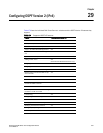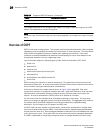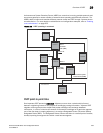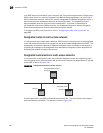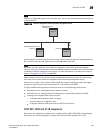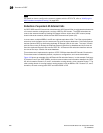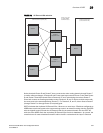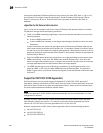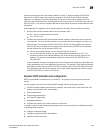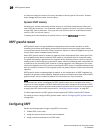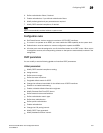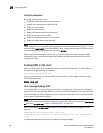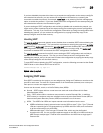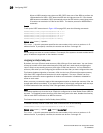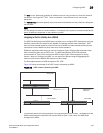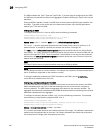
PowerConnect B-Series FCX Configuration Guide 929
53-1002266-01
Overview of OSPF
29
All three networks have the same network address, 10.0.0.0. Without support for RFC 2328
Appendix E, an OSPF router uses the same link state ID, 10.0.0.0, for the LSAs for all three
networks. For example, if the router generates an LSA with ID 10.0.0.0 for network 10.0.0.0
255.0.0.0, this LSA conflicts with the LSA generated for network 10.0.0.0 255.255.0.0 or 10.0.0.0
255.255.255.0. The result is multiple LSAs that have the same ID but that contain different route
information.
When Appendix E is supported, the router generates the link state ID for a network as follows.
1. Does an LSA with the network address as its ID already exist?
• No – Use the network address as the ID.
• Yes – Go to step 2.
2. Compare the networks that have the same network address, to determine which network is
more specific. The more specific network is the one that has more contiguous one bits in its
network mask. For example, network 10.0.0.0 255.255.0.0 is more specific than network
10.0.0.0 255.0.0.0, because the first network has 16 ones bits (255.255.0.0) whereas the
second network has only 8 ones bits (255.0.0.0):
• For the less specific network, use the networks address as the ID.
• For the more specific network, use the network broadcast address as the ID. The
broadcast address is the network address, with all ones bits in the host portion of the
address. For example, the broadcast address for network 10.0.0.0 255.255.0.0 is
10.0.255.255.
If this comparison results in a change to the ID of an LSA that has already been generated, the
router generates a new LSA to replace the previous one. For example, if the router has already
generated an LSA for network with ID 10.0.0.0 for network 10.0.0.0 255.255.255.0, the router
must generate a new LSA for the network, if the router needs to generate an LSA for network
10.0.0.0 255.255.0.0 or 10.0.0.0 255.0.0.0.
Dynamic OSPF activation and configuration
OSPF is automatically activated when you enable it. The protocol does not require a software
reload.
You can configure and save the following OSPF changes without resetting the system:
• All OSPF interface-related parameters (for example: area, hello timer, router dead time cost,
priority, re-transmission time, transit delay)
• All area parameters
• All area range parameters
• All virtual-link parameters
• All global parameters
• Creation and deletion of an area, interface or virtual link
In addition, you can make the following changes without a system reset by first disabling and then
re-enabling OSPF operation:
• Changes to address ranges
• Changes to global values for redistribution
• Addition of new virtual links



